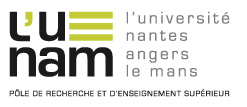Formulating preliminary design optimization problem of an agrifood process using expert knowledge: application to milk microfiltration
Résumé
Modelling and optimizing food processes is a complicated task due to the high complexity of the food product itself, the lack of knowledge concerning mechanisms limiting process performances [1], and to the heterogeneity of the involved variables (ordinal, cardinal, discrete or continuous variables). This is the case for skim milk crossflow microfiltration with 0.1 μm pore size (MF 0.1 μm). This operation is commonly used in dairy industry to separate proteins: native casein micelles (retentate) are used in cheese making while serum proteins (permeate) are mainly used in food formulations for specific populations (elderly people, infants, etc). Despite the high interest in MF in the dairy sector, this process is not optimized by considering the different conflicting objectives of the industry such as maximizing protein recovery in the permeate fraction while minimizing economic costs. The choices of membrane configurations, processing designs and operating conditions are based on the know-how of operators and the available expert knowledge. This knowledge is partial and does not take into account links between the process operating variables, product state variables and optimization objectives. When the optimization of MF 0.1 μm is performed, it is often described as mono-objective and empirical problem [2] or as study cases showing the influence of one variable on a group of chosen variables [3]. This article presents a methodology for collecting, collating and representing expert knowledge necessary to the design of food processing multi-objective optimization problems focusing on skim milk MF.
2. Methods
The proposed methodology has four steps: formulation of the multi-objective optimization problem, modelling optimization objectives as functions, optimization of objective functions and choice of a solution to implement [4]. In this work, the focus is on the problem formulation. The
MF 0.1 μm optimization problem is multidisciplinary and the knowledges necessary to formulate and solve the problem are shared between several experts. By dividing the problem domain into domains of knowledge, the identification of experts and the knowledge collection are easier [5]. The semi-structured interview was used to elicit know-how and knowledge from experts. The influence relations between variables and objectives were collected from the interviews and represented as causal maps. Graphical representation allows expert to exchange easily about influence relations. After validations, maps of the same knowledge domain were merged, discussed and validated by the group of the domain experts. Maps represent the knowledge models to use for formulating the optimization objectives as functions from the literature or experimental data.
3. Results and discussion
In this work, the operational objective is to be able to compare optimized microfiltration systems within a global process that can accept different membranes, processing designs and operating conditions. Optimization objectives were defined with the stakeholders: ten experts and decision makers. First, ten objectives were defined and reduced to six regarding industrial issues (maximization of the retentate composition, permeate composition, permeate protein recovery and stability of the permeation flux and minimization of the investment cost and operating cost). The MF 0.1 μm optimization problem domain was divided into nine knowledge domains: membrane properties, performance of the filtration, operating variables, permeate fraction, retentate fraction, process design, costs and environmental impacts. Each knowledge domain benefited from two to seven experts. Knowledge was collected during 36 interviews representing 14h30 of audio recording. For each knowledge domain, a causal map by expert was established and the whole merged as the causal map of the domain. After validations, each domain causal maps were discussed and validated by the different domain experts (industrialists, scientists, equipment manufacturers). One very important point of this step was to define a shared glossary and a generic process scheme representative of all the specific schemes. By the end, the extracted causal relations between variables were represented in 9 maps using approximately 250 variables.
4. Conclusions
The optimization problem studied is complex with conflicting objectives and heterogeneous variables. The integration of expert knowledge allows the identification of relevant objectives regarding to industrial issues. The MF process is considered from conception to performances with the identification of lack of knowledge in order to plan new experiments. Causal maps allow an easy to understand representation of the influences between the variables and make it possible to establish which variables influence which objectives. Based on these maps, the objective functions will be formalized allowing to perform the optimization.

